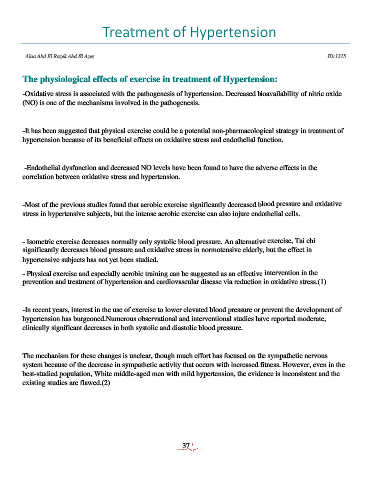Page 37 - G43 ASSIGNMENT
P. 37
Treatment of Hypertension
Alaa Abd El Razek Abd El Azez ID:1315
The physiological effects of exercise in treatment of Hypertension:
-Oxidative stress is associated with the pathogenesis of hypertension. Decreased bioavailability of nitric oxide
(NO) is one of the mechanisms involved in the pathogenesis.
-It has been suggested that physical exercise could be a potential non-pharmacological strategy in treatment of
hypertension because of its beneficial effects on oxidative stress and endothelial function.
-Endothelial dysfunction and decreased NO levels have been found to have the adverse effects in the
correlation between oxidative stress and hypertension.
-Most of the previous studies found that aerobic exercise significantly decreased blood pressure and oxidative
stress in hypertensive subjects, but the intense aerobic exercise can also injure endothelial cells.
- Isometric exercise decreases normally only systolic blood pressure. An alternative exercise, Tai chi
significantly decreases blood pressure and oxidative stress in normotensive elderly, but the effect in
hypertensive subjects has not yet been studied.
- Physical exercise and especially aerobic training can be suggested as an effective intervention in the
prevention and treatment of hypertension and cardiovascular disease via reduction in oxidative stress.(1)
-In recent years, interest in the use of exercise to lower elevated blood pressure or prevent the development of
hypertension has burgeoned.Numerous observational and interventional studies have reported moderate,
clinically significant decreases in both systolic and diastolic blood pressure.
The mechanism for these changes is unclear, though much effort has focused on the sympathetic nervous
system because of the decrease in sympathetic activity that occurs with increased fitness. However, even in the
best-studied population, White middle-aged men with mild hypertension, the evidence is inconsistent and the
existing studies are flawed.(2)
37

